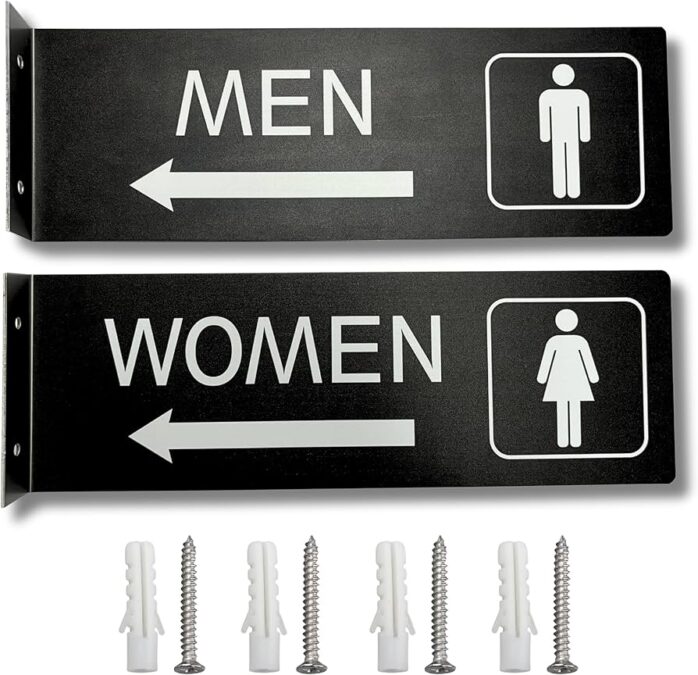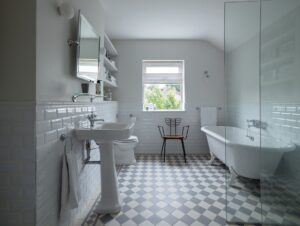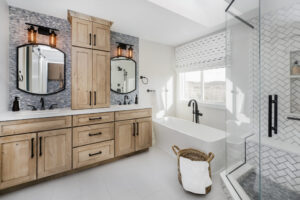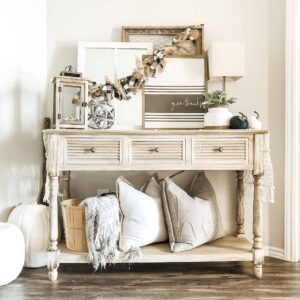Bathroom Signs: More Than Just Directions—A Statement of Style and Inclusion

It was a quiet afternoon when Megan found herself in her favourite local cafe, enjoying her usual coffee and catching up on some reading. After a while, she needed to use the restroom. She looked up from her book, scanning the room for a bathroom sign. Her eyes settled on a door with an odd symbol that left her momentarily confused. It was neither a traditional “Male” nor “Female” sign but an abstract figure that seemed to blend elements of both. Unsure it was the right door, she hesitated, waiting for someone else to enter before following. Later, she realized that the symbol was a modern interpretation of an all-gender bathroom sign designed to be inclusive yet still ambiguous for those unfamiliar with its meaning.
This simple incident got Megan thinking: how often do bathroom signs, meant to provide clear direction, lead to confusion instead? And beyond that, what message do they send about the places where they’re displayed? Whether in a public space or a home, bathroom sign are no longer just practical tools. Today, they reflect values, convey personality, and even contribute to making spaces more inclusive.
In this article, we’ll explore the evolution of bathroom signs, their role in modern design, and how they’ve become a tool for businesses to make statements about inclusivity, humour, and style. We’ll also provide insight into how bathroom signs can enhance the functionality and ambience of both public spaces and homes.
The History of Bathroom Signs: From Simple to Symbolic
Bathroom signs have evolved significantly over the years. They served one purpose in their most basic form: to guide people to the right bathroom as quickly and efficiently as possible. Early bathroom signs were straightforward—simple “Men” and “Women” labels often accompanied by symbols of stereotypical male and female figures. However, as societal views around gender have evolved, so too have bathroom signs.
In recent years, businesses and public institutions have increasingly adopted more inclusive bathroom signage. According to a 2020 report by Statista, 28% of U.S. businesses with public restrooms have transitioned to gender-neutral or all-gender bathroom signage in response to growing awareness and acceptance of non-binary and transgender identities. These new signs often replace the traditional “man” and “woman” symbols with abstract figures or a mix of symbols to ensure all people, regardless of gender identity, feel welcome.
But this evolution hasn’t been without its challenges. Megan’s experience shows that these modern signs can sometimes confuse those accustomed to traditional labels. This raises the question: How do we balance inclusivity with clarity, and can bathroom signs serve a purpose beyond just guiding people?
The Rise of Humorous and Creative Bathroom Signs
In addition to inclusivity, another trend in bathroom signage is the growing use of humour and creativity. Restaurants, cafes, and bars, in particular, have begun to adopt witty and artistic bathroom signs to match their unique brand identities. Whether it’s a quirky illustration, a clever pun, or a pop-culture reference, these signs often leave a lasting impression on patrons.
For instance, a 2019 Restaurant Design Trends survey by Houzz revealed that 43% of restaurant owners who redesigned their spaces in the last five years opted for custom bathroom signage to enhance the overall ambience and align with their brand’s personality. This shows that bathroom signs, while functional, can also be a key design element, reflecting the mood and vibe of a space.
Consider the bar in Brooklyn that uses images of Beyonce for the women’s bathroom and Drake for the men’s bathroom. Or a hip coffee shop in Los Angeles that humorously labels its bathrooms as “Don’t Pee Here” and “Definitely Don’t Pee Here.” These bathroom signs do more than a guide—they contribute to the experience of visiting the establishment. They become part of the memory, something people talk about, laugh at and even post on social media.
A survey conducted by Social Media Today in 2022 found that 22% of Instagram users have shared or tagged images of humorous bathroom signs during their visits to cafes, bars, or restaurants. These signs, which once served only a practical purpose, are now part of the aesthetic appeal that enhances a venue’s reputation, particularly among younger, social media-savvy generations.
The Role of Bathroom Signs in Homes
Bathroom signs are for more than just public spaces. In recent years, homeowners have used bathroom signs to add personality to their home décor. Whether it’s a cheeky “Wash Your Hands” reminder or a chic label distinguishing “His” and “Hers” bathrooms in larger homes, these small touches can enhance the functionality and style of residential spaces.
According to HomeAdvisor’s 2022 interior design trends survey, 35% of homeowners added bathroom signs as part of bathroom renovations, viewing them as decorative and functional. In particular, homeowners with guest bathrooms often use these signs to bring humour or elegance into the space. Simple additions like “Powder Room” or “Relax, Refresh, Repeat” signs can make a small bathroom feel more welcoming and styled.
For families with children, bathroom signs can even serve an educational purpose. Signs saying “Brush Your Teeth” or “Flush” can be fun reminders for little ones, making daily routines more enjoyable. As design experts from Better Homes & Gardens note, incorporating playful signage in a child’s bathroom can help foster independence while keeping the space lighthearted and fun.
Inclusivity and Accessibility in Bathroom Signage
As public awareness around inclusivity grows, bathroom signage is increasingly seen as a reflection of a business’s or public space’s values. Gender-neutral and all-gender bathrooms are on the rise, especially in progressive cities and educational institutions. According to a 2021 report by the Williams Institute, 61% of U.S. universities and colleges had at least one all-gender restroom on campus, a significant increase from previous years.
In corporate settings, the move toward inclusive signage is becoming more widespread. A 2022 survey from the Society for Human Resource Management (SHRM) found that 37% of large companies (with over 500 employees) had introduced all-gender bathrooms as part of their diversity and inclusion policies. For many businesses, adopting inclusive bathroom signs is about complying with anti-discrimination laws and fostering a welcoming environment for employees and customers.
However, beyond gender inclusivity, bathroom signs are essential in making spaces more accessible. Braille signage, for instance, has become a standard feature in public restrooms across the U.S. under the Americans with Disabilities Act (ADA). This ensures that individuals with visual impairments can easily navigate public spaces. Meanwhile, directional bathroom signs highlighting accessible stalls or family restrooms help parents, caregivers, and people with disabilities find appropriate facilities.
A study conducted by the ADA National Network in 2020 found that 85% of public buildings in the U.S. were compliant with bathroom signage regulations under the ADA. However, advocates argue that beyond compliance, businesses should consider how inclusive signage—both in terms of gender and accessibility—can further enhance the experience for all patrons.
Practical Considerations for Choosing Bathroom Signs
Whether for a business or a home, choosing the right bathroom sign requires some practical considerations:
1. Visibility and Clarity
At its core, a bathroom sign should be easy to read and understand. For businesses, it’s essential to ensure that the sign is visible from a distance and uses clear language or symbols. While creative signs are fun, they shouldn’t compromise functionality. Symbols should be recognizable, and text should be legible.
2. Durability
In high-traffic areas, bathroom signs must be durable and easy to clean. Materials like acrylic, metal, or wood offer long-lasting options that withstand wear and tear. According to Facility Management Magazine, 58% of businesses opt for metal or acrylic bathroom signs for their durability in high-use public restrooms.
3. Brand Alignment
The bathroom sign should align with the brand’s overall aesthetic for businesses. The sign should feel like a natural extension of the space through colour schemes, fonts, or design elements. Custom bathroom signs allow companies to match the tone of their establishment, whether modern, quirky, or elegant.
Conclusion: The Power of the Bathroom Sign
Megan’s experience in the cafe reminds us that bathroom signs, though small and often overlooked, play an essential role in shaping how we interact with spaces. From guiding people to the proper restroom to making statements about inclusivity, humour, and design, bathroom signs have evolved far beyond their practical function. In today’s world, they can enhance a business’s brand, reflect social values, and even add a touch of personality to a home.
As bathroom signs evolve, their power lies in their communication ability—offering a moment of levity, ensuring accessibility for all, or making someone feel welcome. They are no longer signs on a door; they are an integral part of how we experience spaces, from trendy cafes to our homes.






